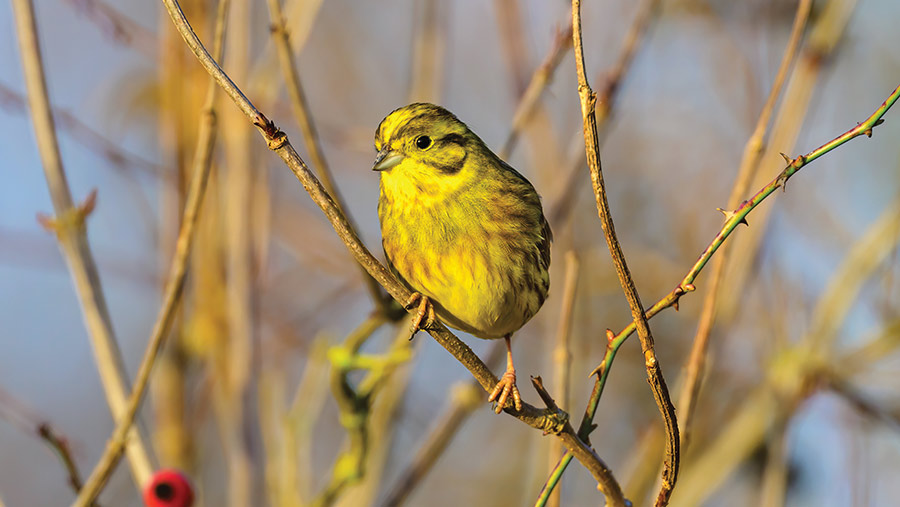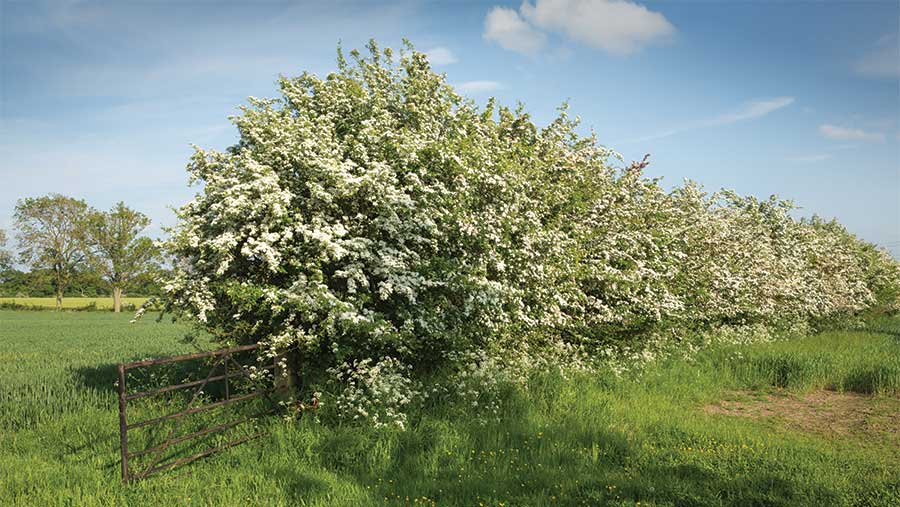How arable farms can support farmland bird populations
 © Adobe Stock
© Adobe Stock A good, varied arable rotation, along with winter bird food stewardship options and a variety of hedges, will provide most of what farmland birds need to survive and thrive.
Adding flower and grass margins, as well as ditches or ponds, can create habitats to support wildlife and their life cycles.
Experience shows that a mix of winter and summer habitat is essential, as is a strategic combination of one and two-year stewardship mixes.
This is according to Suffolk farmer Patrick Barker, who has worked hard to create the right conditions for farmland birds on the 545ha family farm, near Stowmarket.
See also: How to go about improving arable hedges with SFI incentives
The launch site of the first farmland bird count organised by the Game and Wildlife Conservation Trust, 11 years ago, Lodge Farm is proof of what can be achieved in an arable landscape when a whole farm approach is taken.
Patrick stresses that Sustainable Farm Incentive and Countryside Stewardship actions – such as winter bird food (AB9 or AHL2), which pays £853/ha – can be used to help keep birds fed through the winter.
In turn, this means that they start breeding earlier in the spring.
“Consider these areas as a crop, where the yield is birds,” he says. “That helps to inform how you should manage them and where they should be placed.”
Flower-rich margins (AB8 and AB1) also play their part and are worth £798/ha and £739/ha, respectively, boosting insect and invertebrate numbers on the farm, he says.
What’s the current farmland bird situation?
The latest update (November 2023) revealed that the breeding farmland bird indicator continues to fall, having declined by 60% between 1972 and 2022.
While most of these declines occurred in the late 1970s and early 1980s, they are ongoing.
The farmland specialists showing the most prominent decline are corn bunting, grey partridge, turtle dove and tree sparrow, which have fallen by at least 90% since 1970.
RSPB conservation officer Mark Nowers believes there are 19 species that need farmland – 16 of which are indicator species – and every lowland arable farm should aim to have them.
However, it’s not all doom and gloom for birds. Numbers of some farmland species have more than doubled in that time, including stock dove and goldfinch.
Digging into the headline figures is important, advises Jim Egan, technical adviser at Kings, who notes that some species are recovering and there is mounting evidence that the agri-environment schemes are working.
“Where farmers are delivering food and habitat through these schemes, they are seeing a change. Arable land is not as bad as is sometimes made out.”
Game and Wildlife Conservation Trust’s director of advisory and education, Dr Roger Draycott, highlights the results that have been recorded with yellowhammers, a red list species and one that is closely tied to arable landscapes.
“Where wild bird seed mixes and supplementary feeding are carried out together on farmland, there has been a four-fold increase in yellowhammers recorded,” he says.
Extensive monitoring work has shown that there are 278 species supported by the farm’s flowering margins, including nine bat species.
“On this farm, we have been building biodiversity from the base and we are focused on doing it all year round,” says Patrick.
AB12, supplementary feeding for farmland birds at £732/ha, should be done in tandem with winter bird food mixes, recommends David Whiting of Natural England.
He says there’s little point having birds breed one year, only to starve the next.
“These actions should be done together. The other consideration is not to have the whole area devoted to winter bird food in a one-year mix, even though two-year mixes can be more challenging to establish and manage.”
Supplementary feeding involves putting out a mix of cereals and other small seeds every week in the winter until 30 April – reflecting the different dietary preferences that certain species have.
“Yellowhammers love wheat; linnets go for rapeseed.”
David adds that having kale in a two-year AB9 mix provides late seed in the second winter.
The weather can be the limiting factor in getting successful kale establishment in late spring and summer, he accepts, but knowledge is improving and the latest recommendations reflect that.
For Patrick, there are three key factors when it comes to encouraging farmland birds.
“You need to have a year-round supply of food for them, so a whole farm approach works best.
“There also has to be safe nesting and brood rearing habitat. Shelter belts with grassy margins work well – let natural systems take over in these areas.”
His final point is about protection. “Birds need protecting from everything. That means people, dogs and predators – plus anything else that will disrupt or disturb them.”
Hedge management
In winter, hedges need to be a form of protection for farmland birds, says Richard Negus, hedgelayer and conservationist.
He advises that hedge condition must be suitable for providing a ‘thorny embrace” for birds when they are at their most vulnerable, which is why having a hedgerow plan is recommended.
“Hedges are the arteries of the land and their condition matters,” he says. “As well as providing habitat for birds, they are essential for supporting insects.
“Once they’ve been assessed and are managed with a plan, a skilled operator will be able to shape the hedge so that it gets bigger and bigger.”
Where coppicing has to be carried out, dead hedging can be used to protect the new growth from deer and provide a temporary windbreak and refuge, as well as putting the brash from coppicing to good use, he suggests.
Having a variety of hedges on the farm will support different bird species and contribute to overall success, acknowledges the RSPB.
While bullfinches prefer a big ranging hedge, yellowhammers seek out tightly cut hedges, it reports.

Hawthorn hedges offer shelter, boost insects that birds feed on, and provide berries in the autumn © Tim Scrivener
Farmland birds: What to provide
- Winter food
- Flowers and grass
- Variety of hedges
- Wide arable rotation
- Protection.

